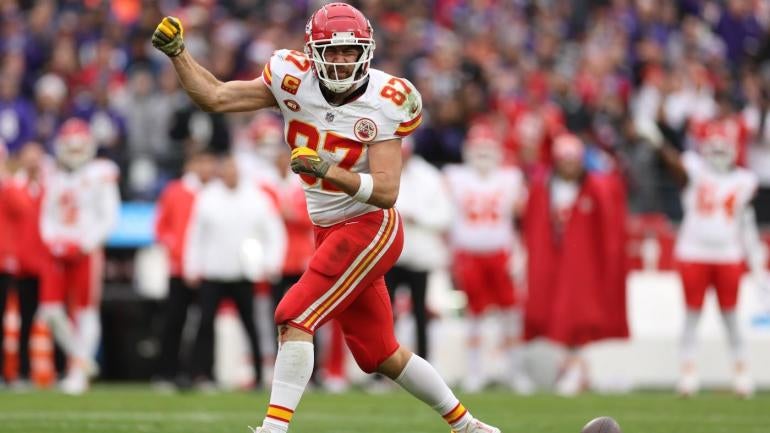
Recency bias is one helluva drug. And it's hard to escape being a prisoner of the moment. The conference title games and Super Bowl always shape narratives for how to build a team, what style of offense and defense to incorporate, what the rest of the league should prioritize during the team-building process, etc. Happens every year. After the Eagles' first Super Bowl win, their usage of the "run-pass option" made RPO vernacular overnight. Mahomes' Super Bowl win the following year pushed the new mold for the prototypical franchise quarterback.
Two years ago, I highlighted the league's growing propensity to go for it on fourth down, pass on first down, and prioritize YAC. Those trends aren't going anywhere. To touch on them briefly here: teams are still noticeably more aggressive on fourth down than they were even five to 10 years ago. That's good.
Last year, investing heavily in the offensive line -- see: the 2022 Bengals, Chiefs, 49ers, and Eagles -- taking fliers on quarterbacks in the draft when in doubt -- Jalen Hurts, Brock Purdy -- and being aggressive -- Kansas City's trade of Tyreek Hill -- were the trends I identified.
Sometimes, these trends are drawn directly from the regular season. But they're mostly drawn from the playoffs.
Let's identify those trends before Super Bowl LVIII.
Motion, motion, and more motion
The two Super Bowl participants finished the regular season in the top 5 in motion rate. The 49ers motioned on a seismic 70.4% of their offensive plays, the second-highest rate the league. The Chiefs came in fourth at 60.5%.
But it doesn't stop there.
The Dolphins, coached by Kyle Shanahan disciple Mike McDaniel, made motioning at the snap all the rage in the NFL. While Miami led the league in that category, there was a strong motion-at-the-snap presence in the conference championship games. The Ravens motioned at the snap on 28.2% of their plays (sixth), the Lions on 28.9% (fifth), and the 49ers on 37.7% (second) in that new-age stat category.
Manipulating the defense a split second before the snap, or better yet, gaining an alignment advantage on the defense without its players having the time to adjust, has proven to be a gigantic boon for NFL offenses.
The 49ers, counting the playoffs, are first in Expected Points Added per play, while the Lions were sixth and the Ravens were seventh.
Long live YAC
How much more clear-cut could this trend be? The No. 1 and No. 2 teams in yards after the catch per reception are in the Super Bowl. The 49ers have led the NFL in this vital category in six consecutive seasons (!), while the Chiefs have registered the most total yards after the catch in each of the past four years during the regular season.
Bananas, right?
The NFL's two most consistent Super Bowl contenders of late, who've appeared in each of the last three title games in their respective conferences -- and it's been six straight for the Chiefs and four of the past five in the NFC for the 49ers -- are the most consistent and dynamic YAC teams. Could be more correlation than causation, but that correlation cannot be ignored.
Whether it be by scheme or by players added at running back, receiver, and tight end (in a perfect world, it's a combination of the two), the Chiefs and 49ers have actually made it quite obvious for a while now; after all, six years in the NFL is an eternity.
YAC can be the foundation of an offense.
This trend needs to carry into the 2024 season for the rest of the league.
Stay true to your identity
Sure, the great teams can and typically adapt to their opponents. Exploiting weaknesses, along with shifting game plans and overall philosophies, absolutely matters. Teams that can only win one "way" can find advancing in the playoffs an insurmountable challenge.
While those theories are sensible, when in crunch time, particularly in January, teams must lean on what they do best. And we saw what transpires when teams do that -- and when they don't -- in the conference championship games.
The Ravens averaged more than 31 rushes per game in the regular season. They were third in EPA per rush and yards per carry at 4.9. Despite battling in a low-scoring game that saw the defense put the clamps on the Chiefs offense in the second half, Baltimore ran the football just 16 times in the AFC title game. Gus Edwards had a 15-yard carry in the first quarter. He didn't have another carry until the third quarter and finished the game with three carries for 20 yards. The veteran rusher had 13 contests with at least 10 carries on the year.
Oh, and the Chiefs entered Sunday's AFC championship game 28th in EPA per rush allowed. The Ravens squandered a massive opportunity to grind Kansas City on the ground.
Despite nearly 40 attempts from Patrick Mahomes -- which is never a bad idea -- this season, Kansas City had been most effective when Isiah Pacheco was a foundation of the game plan, particularly late in the season. He toted the rock 24 times in Baltimore.
Regarding the Lions (and for the record, I applaud Dan Campbell for not venturing away from his season-long philosophy of typically going for it on fourth down in almost every situation (within reason)): Firstly, the "kick or go" models spit out essentially the same win probabilities for either choice in both fourth-down decisions for Campbell in the second half. Secondly, let's not forget the Lions went on to win some games during the regular season as a direct result of Campbell's "aggression."
The 49ers, meanwhile, started motioning to get advantages in the numbers game on the ground. That was integral to their ferocious comeback against Detroit.
In those high-pressure situations, teams must avoid outsmarting themselves. Do what you do best.
















